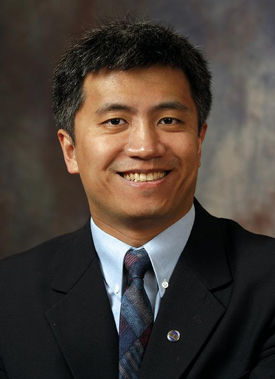Dr. Chang Liu
The PhysOrg article Flexible tactile sensors could help robots work better said
“A robot’s sensitivity to touch could be vastly improved by an array of polymer-based tactile sensors that has been combined with a robust signal-processing algorithm to classify surface textures. The work, performed by a team of researchers at the University of Illinois at Urbana-Champaign, is an essential step in the development of robots that can identify and manipulate objects in unstructured environments.‘We are developing artificial tactile sensors that will imitate the functionality and efficiency found in biological structures such as human fingers,’ said Chang Liu, a professor of electrical and computer engineering at Illinois. ‘We have shown that simple, low-cost sensor arrays can be used to analyze and identify surface textures.’
Biological sensors provide a wealth of information concerning the shape, hardness and texture of an object. Robots, which typically possess a single pressure sensor in their grip, can’t determine whether an object is hard or soft, or how hard it is squeezing an object.”
Chang Liu, Ph.D. is Professor of Mechanical Engineering and Electrical Engineering at Northwestern University.
His research group conducts interdisciplinary research at the interface of mechanical engineering, electrical engineering, biology, and materials. His primary research expertise and endeavors lie in the following areas: microfabrication technology, nanofabrication, bioinspired sensors, and smart integrated systems.
Chang develops novel and efficient fabrication technologies at the microscale and the nanoscale. Often he involves both traditional semiconductor materials as well as non-conventional polymer materials. He focuses on developing MEMS, as well as nanofabrication and nanopatterning technologies. Further, he applies the micro- and nanoscale fabrication expertise to enable new devices and, in turn, new systems and applications.
He is developing biologically inspired sensors — sensors with functions and/or structures based on inspiration from biology. Biology offers exquisite examples of sensors and sensory intelligence. These have been the subjects of observation of biology for hundreds of years. With the advent of micro and nanotechnology, it now becomes possible to build the engineering-equivalent of biological sensors. Through bioinspired sensors research, he seeks to advance engineering as well as deepen understanding of complex biological systems.
Chang received the NSF CAREER award in 1998 and is currently an Associate Editor of the IEEE Sensors Journal. He teaches undergraduate and graduate courses covering the areas of MEMS, solid state electronics, and heat transfer. He is a senior member of the IEEE. He has 13 years of research experience in the MEMS area and has published 100 technical papers.
His work has been cited by the popular media numerous times. He is a cofounder and a member of technical advisor board of NanoInk Corporation. He has consulted for several major MEMS companies. In 2002, he was elected to the “Inventor Wall of Fame” by the Office of Technology Management of the University of Illinois.
Chang authored Foundations of MEMS and coauthored A modular microfluidic architecture for integrated biochemical analysis, Multifunctional Probe Array for Nano Patterning and Imaging, Texture classification using a polymer-based MEMS tactile sensor, Two-Dimensional Micromachined Flow Sensor Array for Fluid Mechanics Studies, Parylene Surface-Micromachined Membranes for Sensor Applications, Polyurethane Rubber All-Polymer Artificial Hair Cell Sensor, and Multisensor Processing Algorithms for Underwater Dipole Localization and Tracking Using MEMS Artificial Lateral-Line Sensors.
His patents include Method for assembly of microelectromechanical systems using magnetic actuation, Parallel, individually addressable probes for nanolithography, Sensor for monitoring material deposition and method of monitoring material deposition, Raised on-chip inductor and method of manufacturing same, Microscale out-of-plane anemometer, Sensor chip and apparatus for tactile and/or flow sensing, Microfluidic systems and components, Apparatus for detecting environmental conditions for a structure or article, Multifunctional probe array system, and Electrostatic nanolithography probe actuation device and method.
Chang earned his B.S. in the Department of Precision Instrument at Tsinghua University, China in 1990. He earned his M.S. in Electrical Engineering at the California Institute of Technology (Caltech) in 1991 and his Ph.D. in Electrical Engineering at the California Institute of Technology (Caltech) in 1996 with the thesis “Micromachined sensors and actuators for fluid mechanics applications”.
Read Chain Mail Fabric a Perfect Fit and Biologically inspired sensors can augment sonar, vision system in submarines.
